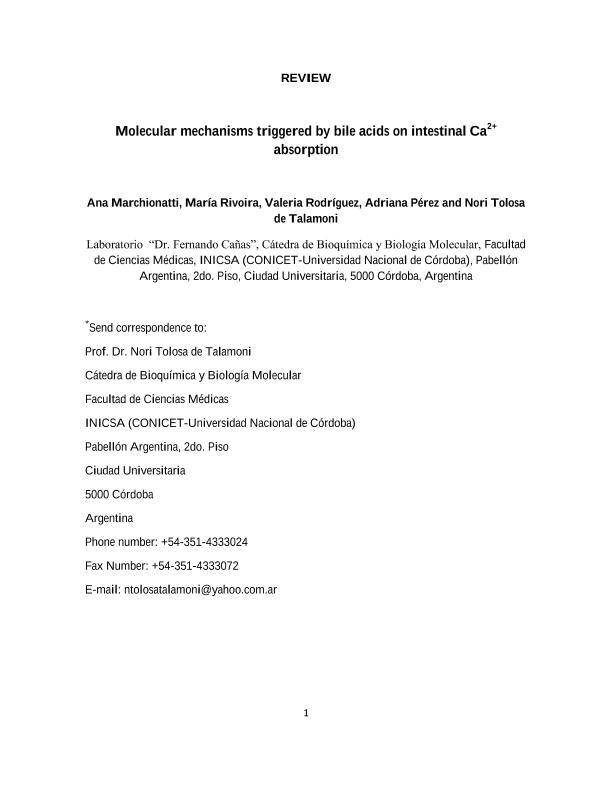Artículo
Molecular mechanisms triggered by bile acids on intestinal Ca2+absorption
Marchionatti, Ana María; Rivoira, Maria Angelica; Rodriguez, Valeria Andrea ; Perez, Adriana; Tolosa, Nori Graciela
; Perez, Adriana; Tolosa, Nori Graciela
 ; Perez, Adriana; Tolosa, Nori Graciela
; Perez, Adriana; Tolosa, Nori Graciela
Fecha de publicación:
10/2018
Editorial:
Bentham Science Publishers
Revista:
Current Medicinal Chemistry
ISSN:
0929-8673
Idioma:
Inglés
Tipo de recurso:
Artículo publicado
Clasificación temática:
Resumen
Background: Bile acids (BAs) are among the main components of bile. Lately, they are also considered important signaling molecules, not only by regulating their own synthesis, but also having a role in several metabolic diseases. Objective: In this review we focus on the effect of sodium deoxycholate (NaDOC), ursodeoxycholic (UDCA) and litocholic (LCA) acids and their combination upon the intestinal Ca2+ absorption. To make clear the actions of those BAs on this physiological process, an overview of current information about the mechanisms by which the intestinal Ca2+ occurs is described. Methods: The PubMed database was searched until 2017, using the keywords bile acids, NaDOC, UDCA and LCA and redox state, apoptosis, autophagy and intestinal Ca2+ absorption. Results: The modulation of redox state, apoptosis and autophagy are mechanisms that are involved in the action of BAs on intestinal Ca2+ absorption. Although the mechanisms are still not completely understood, we provide the latest knowledge regarding the effect of BAs on intestinal Ca2+ absorption. Conclusion: The response of the intestine to absorb Ca2+ is affected by BAs, but it is different according to the type and dose of BA. When there is a single administration, NaDOC has an inhibitory effect, UDCA is an stimulator whereas LCA does not have any influence. However, the combination of BAs modifies the response. Either UDCA or LCA protects the intestine against the oxidative injury caused by NaDOC by blocking the oxidative/nitrosative stress, apoptosis and autophagy.
Archivos asociados
Licencia
Identificadores
Colecciones
Articulos(INICSA)
Articulos de INSTITUTO DE INVESTIGACIONES EN CIENCIAS DE LA SALUD
Articulos de INSTITUTO DE INVESTIGACIONES EN CIENCIAS DE LA SALUD
Citación
Marchionatti, Ana María; Rivoira, Maria Angelica; Rodriguez, Valeria Andrea; Perez, Adriana; Tolosa, Nori Graciela; Molecular mechanisms triggered by bile acids on intestinal Ca2+absorption; Bentham Science Publishers; Current Medicinal Chemistry; 25; 18; 10-2018; 2122-2132
Compartir
Altmétricas



